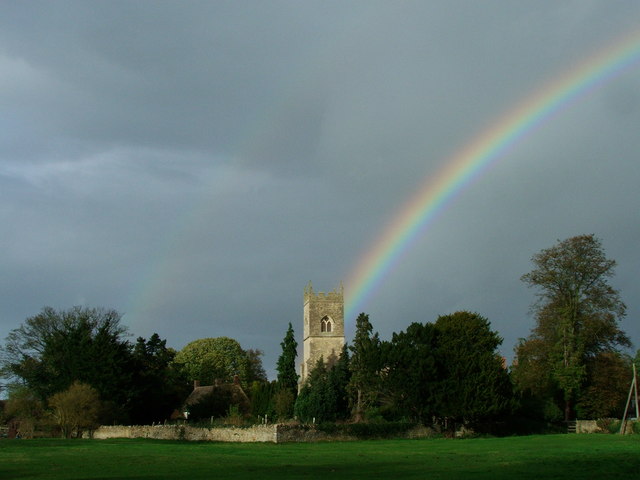Arthur Mee - The King's England - Oxfordshire.
Stratton Audley – Bible Panorama.
 It gathers its houses, great and small, in happy fashion about the church. I a field close by are the grassy banks and hollows where the Audleys built their moated castle. James Audley was one of the original Knights of the Garter, the Black Prince giving him a pension for his valour. The pinnacled tower of the medieval church has an odd little sculpture gallery, with two quaint birds huddled together, and on the wall of the aisle is a fearful gargoyle of a huge bird of pray on a man’s back, the man grasping one of its claws. In the spacious and lofty nave are two arcades of three bays with clustered pillars 600 years old. The chancel has ancient beams it its roof. In some of the windows are fragments of old glass, in which we noticed the head of a lion. The Jacobean pulpit is richly carved, and has four winged heads on the panels.
It gathers its houses, great and small, in happy fashion about the church. I a field close by are the grassy banks and hollows where the Audleys built their moated castle. James Audley was one of the original Knights of the Garter, the Black Prince giving him a pension for his valour. The pinnacled tower of the medieval church has an odd little sculpture gallery, with two quaint birds huddled together, and on the wall of the aisle is a fearful gargoyle of a huge bird of pray on a man’s back, the man grasping one of its claws. In the spacious and lofty nave are two arcades of three bays with clustered pillars 600 years old. The chancel has ancient beams it its roof. In some of the windows are fragments of old glass, in which we noticed the head of a lion. The Jacobean pulpit is richly carved, and has four winged heads on the panels.
On a massive tomb is one of the most remarkable displays we have seen of mass production of ornate sculpture, below which lies Sir John Borlase, lord of the manor in 1688. The heavy canopy has twisted columns of black and white marble with a coat-of-arms, and there are two weeping children at the sides. Below are two draped women holding skulls. Sir John lies on a mattress with curly, flowing locks and wears the meagre trappings of a Roman soldier, a loose sheet is thrown over his legs.
We turn with relief from this mass to the beautiful modern oak screen across the tower, gracefully sheltering under its canopy a font 600 years old. It has solid panels with a door ay each side, with openwork in a band of roundels and in the cornice. In the roundels are a peacock, a fish, and a dove. The cornice is exquisitely carved with fascinating scenes of Bible story. From end to end is a waving band typifying water, in which fishes swim, and on the canopy is Our Lord waist deep in the Jordan, being baptised by John. From right to left of the cornice we see the floods covering the earth, with Noah in the Ark, a cow looking from a window and the dove setting out; fishermen drawing their nets for a miraculous draught of fishes; Pharaoh’s daughter finding Moses in a cradle in the rushes; a pageant of Israelites crossing the Red Sea with the Egyptians, horses, chariots and men overwhelmed by the waters; the Israelites emerging from the waves to the clanging of cymbals: and finally Moses striking the rock.
W. Hobart Bird - Old Oxfordshire Churches.
This spacious church is dedicated to SS. Mary and Edburga. It is so much unfortunate that there ivy growing upon the walls. The tower is Perpendicular, embattled and pinnacled. The aisles and porch have embattled parapets and there is a small image niche over the porch door, which has, inside, a trefoiled holy-water stoup and some stone seats. The North door is Perpendicular.
The interior has quire, clerestoried nave and aisles. The East window is three-light Perpendicular, and there are two-light Perpendicular on North and South with fragments of old stained glass. There is a Decorated trefoiled piscina. Note the two curious old chairs within the sanctuary, also the fine old roof and its corbels.
The North arcade is good Early English having clustered columns with moulded capitals and arches of two chamfered orders with roll labels. The South arcade is somewhat later of an interesting style. The clustered columns have very exaggerated “keels”. The windows North and South are Perpendicular, but on the North at East end has good Decorated tracery and fragments of old glass.
Note the good Jacobean pulpit and at the East end of South aisle a very elaborate but very intrinsic canopied tomb of black-and-white marble, with an effigy resting on his side and clad in the dress of a Roman warrior reclining on a mattress with weeping figures on either side, Johannes Borlasius, 1688.
At the West end of South aisle there is a two-light Decorated window with some old glass. The plain octagonal font is probably late 13th century. Note the sanctus-bell on the gable, also the carefully and very appropriately restored old churchyard cross, now a war memorial to the fallen in the Great War.